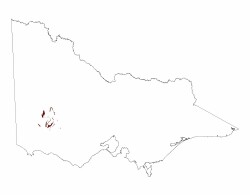2.2.2 Sandstone hills (Black Range)
2. Western Uplands (WU)
2.2 Strike ridges and valleys - Grampians Range
| The western Black Range lies to the west of the Grampians Ranges and consists of dipping sandstone beds of the Grampians Group sediments. Occurring on the Wimmera CMA southern catchment boundary, the ranges play a vital role in supplying pristine water to reservoirs and lakes of the Wimmera and Glenelg-Hopkins regions. As a cuesta landform, the massive beds of quartzose sandstones are extremely resistant to weathering giving significant relief to this range over surrounding plains and sand sheets. Mt Byron (over 500 m) and Mt Talbot (over 300 m) remain as two significant peaks within the structurally controlled sedimentary stack of the western Black Range. Slopes of the range are generally gently inclined with steeper slopes, scarps and cliffs found on the eastern exposures of the range. The Black Range is a structural repeat of the Grampians Group (Spencer Jones 1965) comprising sandstone and a micaceous mudstone overlain by quartzose sandstone (Cayley & Taylor 2001). Sedimentary structures including large-scale aeolian dune cross-bedding in the Daahl Sandstone is prominent in scarps and exposures of these landforms. |  |
Drainage is divided between a short radial network of tributaries (Mochong Creek, Holligan Creek and Matthew Creek) that deliver surface waters to Rocklands Reservoir and creeks that feed the Toolondo Channel and Norton Creek to the north-west. Alluvial deposits are located along many of these defined drainage courses with significant colluvial deposits found on the eastern margin of the strike scarps as well as long westerly dipping rock slopes. Plateau areas support deeper regolith profiles than scarps and steep slopes. Similar soils to the Grampians Ranges occur with the major soils including sandy soils with pans and acidic, grey texture contrast soils with sandy surfaces. Here soils tend to be deeper than those developed on steeper landscapes. The sandy soils with pans (Tenosols and Podosols) comprise organic rich surface sands over a conspicuously bleached subsurface horizon. A further change occurs where a yellow organic and sesquioxide discontinuous pan (coffee rock) sits over mottled clay further down the profile. Grey texture contrast soils (Kurosols) have sandy surfaces with yellow and red mottled light grey clay loams to medium clay subsoils. Both soils have an acidic profile trend with the texture contrast soils strongly acidic. A number of woodland, forest, shrubland and heathland vegetation communities have been recorded within the Black Ranges. Rocky outcrop Shrubland and Rocky Outcrop Herbland are associated with scarps and bedrock exposures while woodlands and forests are located on exposed western slopes or sheltered eastern slopes. Dry sclerophyll forests with Brown Stringybark (Eucalyptus baxteri), Long leaf box (Eucalyptus goniocaylx), occasional Messmate (Eucalyptus obliqua) in wetter areas, and heath understorey. | |


